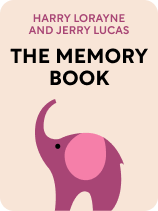

This article is an excerpt from the Shortform book guide to "The Memory Book" by Harry Lorayne and Jerry Lucas. Shortform has the world's best summaries and analyses of books you should be reading.
Like this article? Sign up for a free trial here.
Would you like to memorize a poem or the presentation you’re giving next Tuesday? Do you just want some help remembering what you’re supposed to pick up at the store?
The Memory Book by Harry Lorayne and Jerry Lucas aims to help anyone memorize and recall all sorts of information. The authors explain the principles that govern memory, and they share strategies that capitalize on those principles.
Continue reading for an overview of this classic book on memory.
Overview of The Memory Book by Harry Lorayne & Jerry Lucas
The Memory Book by Harry Lorayne and Jerry Lucas is a collection of strategies intended to teach anyone how to improve their memorization skills and recall nearly any kind of information.
Harry Lorayne was a magician, author, and memory expert who began studying memorization techniques after struggling with dyslexia in school. He was known for demonstrating his memory capabilities through his magic tricks, which he showcased on numerous television shows such as The Tonight Show Starring Johnny Carson.
Jerry Lucas is a former NCAA and NBA basketball player who began developing memorization techniques as a child. These helped him excel in school and on the basketball court. Lorayne and Lucas combined their knowledge and created the memory systems that became The Memory Book. Since its first edition was published in 1974, the book has become a classic in the field.
We’ll share some basic memory principles that underpin Lorayne and Lucas’s strategies. Then, we’ll closely examine three of their fundamental memorization techniques:
- Remembering sequences of information using image-based associations
- Creating stand-in words to picture abstract information
- Applying the first two skills to recall sequences of ideas
Basic Memory Principles
Lorayne and Lucas discuss five basic memory principles that guide all of their memorization techniques:
Principle #1: To Remember Something, Create a Foundational Memory of It
The authors argue that when you say you’ve “forgotten something,” it’s typically because you never actually absorbed the information in the first place. To remember something later on, you need to first create a foundational memory of it.
Principle #2: Create Foundational Memories Through Close Observation
To create a foundational memory, pay close attention to what you’re trying to remember and mentally absorb the information (instead of just looking at it). If the thing you want to remember is related to an action—for instance, if you want to remember where you chain your bike—this means actively thinking about the action you’re completing while you’re doing it, even if it’s small.
Principle #3: Visualizing Is Akin to Seeing
According to the authors, visualization—mentally picturing the thing you want to remember—is a great tool for memory creation. Sight is deeply connected to memory, so when you see information, you’re more likely to retain it.
Further, some studies suggest that visualizing an image in your mind activates electrical signals in your brain that are nearly identical to signals activated when your eyes perceive a physical image. Therefore, just imagining you can see something strengthens it in your memory as much as actually seeing it.
Principle #4: Tangible Information Is Easier to Remember
The authors assert that it’s easier to remember information (such as a word) that has a concrete meaning than information that’s abstract and intangible. This applies when using visualization techniques, as something has to have clear, concrete meaning for you to picture it.
Principle #5: It’s Easier to Remember Strange Things
Finally, Lorayne and Lucas state that you’re more likely to remember information (especially an image) if it’s novel, illogical, or strange. In contrast, it’s easy to forget images and information that are ordinary or common.
Fundamental Memorization Techniques
In this section, we’ll explore three of Lorayne and Lucas’s fundamental memorization techniques in detail: how to remember sequences of items using image-based association, how to create stand-in words to make abstract items easier to remember, and how to apply those techniques to remember full ideas in sequence. All of these techniques depend on one or more of the basic memory principles we discussed in the previous section.
Technique #1: Remembering Sequences Through Image-Based Association
The first fundamental memorization technique involves remembering sequences of information using image-based association. According to Lorayne and Lucas, we always use association to commit things to memory, often subconsciously. In other words, we remember things in relation to each other, meaning we can recall anything if we link it to another piece of information we already know.
The following steps will show you how to use your brain’s natural affinity for associations to connect sequential pieces of information, enabling you to remember a full list of words in their original order.
Step 1: Start With a List of Words
To practice this technique, you’ll first need a list of words. These can be anything, but Lorayne and Lucas suggest that nouns and verbs work best because they’re the easiest to picture. Your list can be as long or as short as you want it to be.
Step 2: Create a Strange Mental Image Connecting the First Two Words
Once you have your list, Lorayne and Lucas instruct you to begin memorizing the list by connecting the first two words. Do this by creating a mental image that associates the two words, specifically an image that’s illogical, strange, or silly.
This association technique takes advantage of your brain’s visual-based memory and its tendency to remember unusual things. Coming up with a silly, illogical image also prompts you to consider the information closely, creating your foundational memory of it. The clearer you imagine your strange or silly association image, the more strongly you’ll commit it to memory.
Furthermore, Lorayne and Lucas suggest incorporating action into your mental image, as actions are easier to remember than static pictures.
Step 3: Form Connections Between All of the Words
After creating your association image between the first two words in the list, repeat Step 2 with the rest of the words. The authors state that the second word must be associated with the third, the third with the fourth, and so on.
You can repeat this step for a list of any length, as long as you take the time to form a clear, strange, and dynamic mental image between each pair of items on the list.
Step 4: Practice Frequently
Use the above steps to remember items in any list in their correct order by simply following your image associations down the list. According to Lorayne and Lucas, the best way to become better at this technique is to practice it frequently.
Try creating your own list of words and developing original associations between them. Practice recalling the list in the correct order. As you exercise your imagination over time, it’ll become easier to create silly mental pictures, and your recall will require less effort.
Technique #2: Using Stand-In Words to Remember Abstract Information
Lorayne and Lucas assert that you can also apply the skill of creating associations using silly images to remember abstract information: information you can’t readily picture in your mind. However, as we mentioned previously, the less tangible information is, the harder it is to recall. Therefore, you must add a step to associate the abstract information with neighboring words in a list.
In the following steps, you’ll learn how to picture an abstract piece of information concretely using similar-sounding words as a stand-in.
Step 1: Create a Stand-In Word or Phrase
First, the authors instruct you to create a word or phrase that you can picture to act as a stand-in for abstract information. The word or phrase doesn’t have to match the original word exactly, but it should sound similar enough that it makes you automatically think of the original word.
Step 2: Connect the Stand-In Words or Phrases Through Silly Image Associations
Once you have a stand-in word or phrase for each item in the sequence you wish to remember, create associations between the list items as you did with Lorayne and Lucas’s first memorization technique. Associate each pair of list items by developing silly mental images that connect their stand-in words or phrases.
Technique #3: Remembering Sequences of Ideas Through Association
According to Lorayne and Lucas, you can apply the skills of creating image-based associations and using stand-in words or phrases to remember ideas in sequence. This could be useful when memorizing a speech, learning new concepts from a textbook, or memorizing a script for a presentation.
There are three steps to this technique:
Step 1: Write Down the Text You Need to Memorize
The authors assert that the first thing to do when memorizing a sequence of ideas is to write down everything you want to remember. Incorporate all your key points in the right order. For example, if you’re writing a speech or preparing for a presentation, write your script. Reading this will give you a general sense of the points you need to remember and how they fit together.
Step 2: Choose a Core Word or Phrase for Each Idea
After you write down your sequence of ideas in a script or some other form, choose a core word or phrase from each idea that’ll remind you of its main point. By recalling ideas with a single word or phrase, you don’t have to memorize sentences and paragraphs word for word.
Lorayne and Lucas state that when you memorize longer pieces of text word for word, you risk appearing too stiff and formulaic when you deliver the ideas. Likewise, trying to recall text word for word (instead of memorizing general ideas) may make you stumble if you can’t remember the exact right phrasing.
No matter what your subject is, if you’ve studied and practiced enough, you should be able to talk about it using just your core word or phrase as a reminder—without needing to explain it using the same words every time. Repeat this step for every distinct idea or point in your text.
Step 3: Create a Sequence of Associations Between the Core Words and Phrases
Once you’ve chosen a core word or phrase for each idea, Lorayne and Lucas describe how to use the skills outlined in the first two techniques to create associations between the ideas in your text. These associations help you remember the sequence of your ideas in the correct order. As we did with the list of words in Technique #1, create associations between the core words or phrases you chose using strange, silly images. If your core word or phrase of an idea can’t be pictured easily on its own, add the extra step of creating a stand-in word or phrase that you can create a mental picture for.

———End of Preview———
Like what you just read? Read the rest of the world's best book summary and analysis of Harry Lorayne and Jerry Lucas's "The Memory Book" at Shortform.
Here's what you'll find in our full The Memory Book summary:
- How to improve your memorization skills and recall any kind of information
- Techniques for remembering sequences of information
- How to picture and remember abstract information






